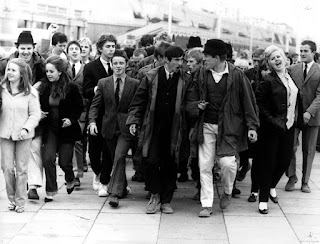
Peter Tscherkassky, in Austria, comes from a long line of avant-garde artists who prefer to work with the actual material of film. Man Ray, and Stan Brakhage and Bruce Connor after him all preferred to work with celluloid, and most resisted making the transition to (arguably cheaper and more flexible) video, and then to digital.
Tscherkassky starts with previously existing footage, reprinting (and misprinting) images over themselves, misregistering the film so sprocket holes become visible, framelines jump in and out of focus, images blur and stutter on top of and into one another. It's filmmaking without a film camera. Only the dark room and some unexposed film, and some previously exposed work which becomes the victim.
His films approach a kind of virtual performance art, embracing and emphasizing the visual surface of the object, as images run through a projector, and we "read" them as they flicker past. It's about film stock and dim light and flash cuts.
The tension has less to do with the narrative content (although that has something to do with it) than with whether or not the film will actually make it to the end without fatal mishap.
This process of re-printing may result in the destruction of the representational. Photography is unique as an artform in that it is more than artistic representation, more than symbolic rendering - for all the artifice created by filmmakers (before and after the shutter is opened), film carries a profound and powerful meaning by being an index of reality.
By moving into a post-modern and self-referential plane, what's shown is no longer nearly as important as how it is shown. Tscherkassky obscures the text, and seems to be suggesting the film is an index of itself, a kind of recursive performance art in which itself is the subject.
And in this process which seems little more than a film-school exercise, subtext in the imagery (which may or may not be intentional) becomes highly visible. Normally "conservative" footage reveals itself to be laden with political meaning, symbolic and stripped of narrative limitations, now free and convulsing as it's seen.
Who needs a camera?









